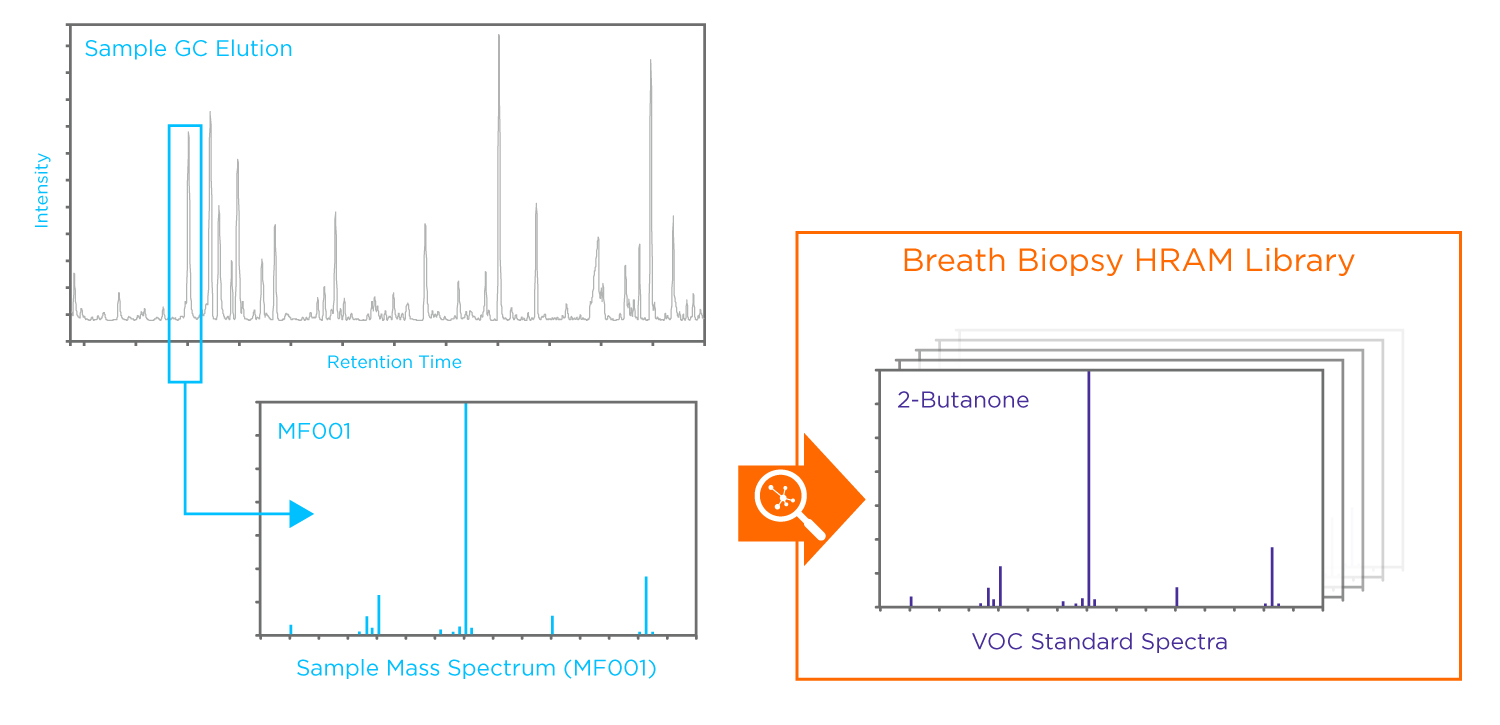Enhancing Biomarker Analysis with the Breath Biopsy HRAM Library
Published on: 30 May 2022
One of the many features of our Breath Biopsy biomarker services is access to the Breath Biopsy High Resolution Accurate Mass (HRAM) Library for identification of potential biomarkers via mass spectrometry. Identifying compounds is an essential step in developing breath tests that can be validated and approved for clinical use. The Library has been uniquely developed with Breath Biopsy to enable high confidence identification of compounds from breath.
The Need for Biomarker Identities
What is a mass spectral library?
Mass spectral libraries can help to identify compounds from data collected through mass spectrometry. Identifying unique chemical entities through mass spectrometry is a widely used technique but includes several inherent challenges. Each molecular feature in the data represents a combination of a specific retention time and mass spectral signature. Libraries are used to deconvolute the data, allowing it to be associated with chemical compounds.
Libraries are an efficient way to streamline identifying compounds. To have a high level of certainty in identifications, you need to analyze samples alongside many pure standard compounds so that the mass spectra from those standards can be matched to features detected in the samples. This is extremely time consuming and expensive so isn’t practical in the context of most trials.
Mass spectral libraries save some of the work by providing a collection of mass spectra produced by various available standard compounds. Spectra from samples can then be compared to the library to infer the identities of compounds in the samples. The US National Institute of Standards and Technology (NIST) maintains an online mass spectrometry library that is widely used to help identify compounds using mass spectrometry.

Figure 1: Compound identification by library matching
What are the advantages of the Breath Biopsy Library?
While it has become common practice to use libraries like NIST in mass spectrometry, they have limitations:
- Coverage – Libraries don’t contain all compounds, usually only ones that are readily available. This means they aren’t useful in other contexts or when studying rare or unusual compounds and so some compounds can’t be identified this way.
- Relevance – Libraries are often created for a specific purpose/application. The compounds included in the library will largely be the ones that are most relevant to that purpose. The Breath Biopsy Library focuses on VOCs found on breath so it is particularly relevant for clinical breath research.
- Analytical Precision – Various analytical pipelines for mass spectrometry analysis exist, based on different experimental procedures, analytical devices and device settings. A generic library such as NIST will always be an imperfect match for the mass spectra produced by any specific study. This can lead to incorrect identifications limiting the level of confidence in your data.
There are many components of the analysis process that can affect the mass spectra that result from any given compound. One key difference that can occur between samples in a study and data from a library, for example, is in retention times. A chromatography column separates mixtures of compounds (such as breath) so that each compound can be analyzed separately by mass spectrometry.
The retention time is the amount of time it takes for a compound to move through the column and reach the mass spectrometer. It is useful in identifying the compound but varies significantly depending on the properties of the column, and other factors. As such, retention time for samples often doesn’t match well to corresponding data in a library, unless the library was created using the same method. Other factors that affect the identification of compounds from mass spectra include, for example, ionization method and energy.
We created the Breath Biopsy HRAM Library to help improve the accuracy of compound identification for Breath Biopsy studies. Our Library was generated using workflows that are also used in our studies and this means that matches can be more precise than with a generic online library. Our rigorous quality checks help us to further limit process variation and improve comparability to library standards. In addition, the compounds included in the library have also been selected based on extensive reviews of available breath research literature. This means that we can offer higher confidence identification specifically for compounds likely to be relevant as breath biomarkers.
Of course, to give you the best chance of developing a targeted breath test that can detect biomarkers with high precision and accuracy in a clinical setting, we still recommend following-up your initial Breath Biopsy study with thorough compound identification to ensure that you can be certain in the identity of your candidate biomarkers before you pursue validation and clinical applications.
How can I use the Library for my research?
The Library currently contains around 140 compounds with reported relevance to breath research, and we plan to investigate and integrate many more. Our expert biostatisticians and translational biologists make use of both the NIST and the Breath Biopsy Library to support data interpretation in all Breath Biopsy OMNI® studies – our complete solution for comprehensive and robust global breath VOC analysis. If you would like to start a study with us, contact us with details about your research aims and we’ll be in touch.
Or, to find out more about using our HRAM Library as part of Breath Biopsy OMNI, read our whitepaper.
